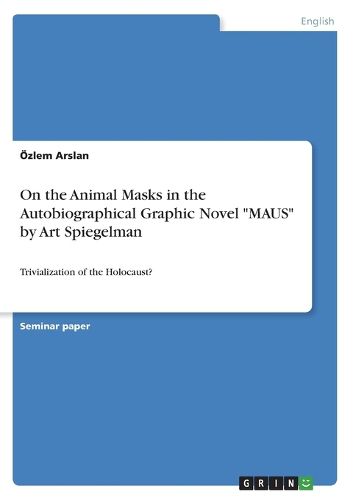Readings Newsletter
Become a Readings Member to make your shopping experience even easier.
Sign in or sign up for free!
You’re not far away from qualifying for FREE standard shipping within Australia
You’ve qualified for FREE standard shipping within Australia
The cart is loading…






Seminar paper from the year 2019 in the subject American Studies - Literature, grade: 1,3, University of Wuppertal (Geistes- und Kulturwissenschaften), course: The Holocaust in Eastern Europe in History and American Literature, language: English, abstract: This term paper aims to examine the function of the animal masks in Art Spiegelman's graphic novel "Maus" with the question in mind whether it trivializes the Holocaust or not. The paper will begin with an introduction to the different types of animal heads and the possible reasons for the choice of the artist by giving some historical background. The main part will discuss the use of the animal masks and its functions by analyzing significant panels from "MAUS". Finally, the paper will also contain a conclusion in which the results will be summarized. "MAUS" is an autobiographically written graphic novel by Art Spiegelman which consists of two parts, "Maus I" (1986) and "Maus II" (1992), and tells the story of the artist's parents, Anja and Vladek, who survived the Holocaust and the reader also gets a view on the afterlife of Vladek and his relationship with his son "Artie". Art Spiegelman received a lot of praise and was celebrated in the press for his work. Amongst other achievements, he was honored with the Pulitzer Prize for "MAUS" in 1992. However, his graphic novel was also criticized for the use of animal masks for the characters. To elaborate on this, Spiegelman chose to depict the affiliation to a religion or culture of characters by using animal make in the past and present time of the graphic novel. For example, cats for Germans, mice for Jews and pigs for Poles. Especially the representation of Jews as mice and Poles as pigs caused many negative critiques from Jewish and Polish people themselves. Furthermore, Spiegelman's presentation method was criticized for naturalizing something unnatural, which means it was perceived as trivializing the Holocaust and by that insulting the victims. Even though t
$9.00 standard shipping within Australia
FREE standard shipping within Australia for orders over $100.00
Express & International shipping calculated at checkout
Seminar paper from the year 2019 in the subject American Studies - Literature, grade: 1,3, University of Wuppertal (Geistes- und Kulturwissenschaften), course: The Holocaust in Eastern Europe in History and American Literature, language: English, abstract: This term paper aims to examine the function of the animal masks in Art Spiegelman's graphic novel "Maus" with the question in mind whether it trivializes the Holocaust or not. The paper will begin with an introduction to the different types of animal heads and the possible reasons for the choice of the artist by giving some historical background. The main part will discuss the use of the animal masks and its functions by analyzing significant panels from "MAUS". Finally, the paper will also contain a conclusion in which the results will be summarized. "MAUS" is an autobiographically written graphic novel by Art Spiegelman which consists of two parts, "Maus I" (1986) and "Maus II" (1992), and tells the story of the artist's parents, Anja and Vladek, who survived the Holocaust and the reader also gets a view on the afterlife of Vladek and his relationship with his son "Artie". Art Spiegelman received a lot of praise and was celebrated in the press for his work. Amongst other achievements, he was honored with the Pulitzer Prize for "MAUS" in 1992. However, his graphic novel was also criticized for the use of animal masks for the characters. To elaborate on this, Spiegelman chose to depict the affiliation to a religion or culture of characters by using animal make in the past and present time of the graphic novel. For example, cats for Germans, mice for Jews and pigs for Poles. Especially the representation of Jews as mice and Poles as pigs caused many negative critiques from Jewish and Polish people themselves. Furthermore, Spiegelman's presentation method was criticized for naturalizing something unnatural, which means it was perceived as trivializing the Holocaust and by that insulting the victims. Even though t